“Growing up there was always a feeling of a bogey man somewhere” Rachael Ball talks about the personal inspirations for Wolf from Selfmadehero
 Having earned a just deserved second place in our recent rundown of the best small press and indie comics of the year 2018, we caught up with Wolf creator Rachael Ball to find out more about the personal influences on it contains and the inspirations for her emotional and complex tale of grief and childhood in the 1970s.
Having earned a just deserved second place in our recent rundown of the best small press and indie comics of the year 2018, we caught up with Wolf creator Rachael Ball to find out more about the personal influences on it contains and the inspirations for her emotional and complex tale of grief and childhood in the 1970s.
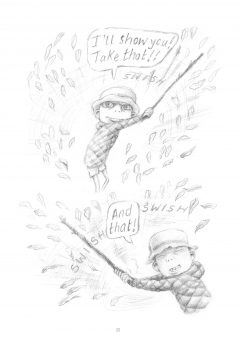 Your latest book Wolf follows a family coping with the loss of a father and moving to a new area, it feels very personal, was it based on an incident in your own life or someone close to you?
Your latest book Wolf follows a family coping with the loss of a father and moving to a new area, it feels very personal, was it based on an incident in your own life or someone close to you?
Rachael Ball: The story is based on the death of my father when I was 6. He died suddenly in the night of a heart attack. I wanted to tell the story of how children respond to grief. There’s an idea that kids don’t feel death like adults do. But kids are living in the present so much they don’t deal with it in the same way as adults. Also children are very sensitive to upsetting their parents and parents are putting on a brave face so you tend to get this wall of silence around the loss of this really important person. This makes for a lot of squashed down feelings around great loss. I wanted to look at that loss and I also wanted to give my Dad something. Even though he’s been gone so long. Wolf is my gift to him.
It is set in the summers of 1976 and 1977, was this period setting part of that personal link to the story or part of a conscious choice to tell a story in that time setting?
RB: He died in 1970. It was important to me to relive that period when telling the story and to evoke that period. Firstly so that I was there again to make the story authentic and to access the real feelings, things and references from that time. I was very conscious of trying to convey the shock of loss even at such a young age and making it real to the time period was part of that. I also thought that it would help people who had lived through the 70’s connect with the story if they had the same references to relate too. Having said that a lot of the story is fictional.
 References to Wolves crop up in different forms throughout the book rather than it have just one central wolf themed character or element. Was Wolf the working title throughout? And what is it about wolves which seemed to fit the story ideas you had?
References to Wolves crop up in different forms throughout the book rather than it have just one central wolf themed character or element. Was Wolf the working title throughout? And what is it about wolves which seemed to fit the story ideas you had?
RB: Wolf was always part of the title although originally the title was Wolf man. The title was changed quite late in the day as Selfmadehero had already published a book by the same name.
The story is told through the eyes of Hugo (aged 6), and I wanted to show how a child responds to experiences through their own knowledge. That knowledge is based on their own small community and the awareness of the world that they’ve built up so far such as fairy tales, nursery rhymes, scary tales and games. The wolf is a classic, universal symbol of fear and foreboding. So I used the wolf at the start of the story (when Hugo and his Dad are on an idyllic last walk in a forest), as a sign of impending doom. Later the wolf becomes the Wolf man, his new neighbour.
When I look back to growing up there was always a feeling of a bogey man somewhere. Someone we thought of as an intriguing but terrifying figure who maybe lived nearby. I liked the idea of taking such a figure and making them central to Hugo’s story. He wants to bring his Dad back. He can’t accept his Dad’s death. Surely, I thought , if he was going to be able to do something so incredible, he would need some great force of nature to achieve it. Wolves in literature are interchangeably positive and negative so they seemed ideal for that purpose. And so that symbol became the Wolf man.
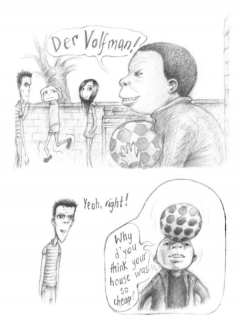 The idea of kids creating stories around a mysterious neighbour is a really interesting one. I really liked the way you used that idea to help the kids create this boogeyman next door, but ultimately Hugo finds out the all too human truth behind it. Was this again based on your own childhood experiences?
The idea of kids creating stories around a mysterious neighbour is a really interesting one. I really liked the way you used that idea to help the kids create this boogeyman next door, but ultimately Hugo finds out the all too human truth behind it. Was this again based on your own childhood experiences?
RB: I can remember a time when we went caravanning..I think it was to Hutton Roof in Cumbria. Lots of caravanning and wintry walks when I was a kid! My friends played a joke on me and left a note on the ground outside the caravan from some men talking about ‘watching us’ and ‘coming to get us!’ etc. I got really scared and kept watching out for them all the time. I started seeing the same van appear in the country lanes and I was convinced that was them. They tried to convince me that it was a joke. I wouldn’t believe them and I can still remember the total fear I experienced all the time. Plus there were always Bogey men under your bed! I used to leap the last few steps before getting into my bed so they couldn’t grab me from under it!!
The death of the father is a very potent and poignant event that the story is built on, but his actual death almost feels a little bit comical or farcical, was that intentional or are we misreading it?
RB: That scene I re-did many times. Initially I drew the scene dramatically but the imagery reminded me of the footage from the Twin Towers tragedy and that felt wrong. It’s very hard to treat such subject matter without getting it wrong. Further dramatic attempts felt like a pastiche of death scenes we’ve seen so many times before on TV. This is a story of real loss. I didn’t want to be gratuitous about it.
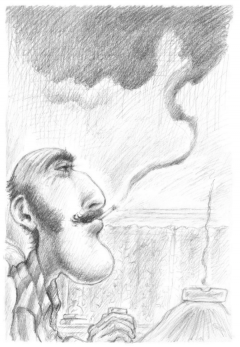 I could have kept true to the real story and have the father dying in an ambulance in the night but I didn’t know what really happened there and Hugo wouldn’t have done either. I chose the father to die in that way because I wanted it to be so unexpected, so shocking. The end version is almost comical because it became how Hugo or a child might have imagined it. And it being a foolish death and an unexpected approach to dying felt more authentic in the end to a realistic retelling.
I could have kept true to the real story and have the father dying in an ambulance in the night but I didn’t know what really happened there and Hugo wouldn’t have done either. I chose the father to die in that way because I wanted it to be so unexpected, so shocking. The end version is almost comical because it became how Hugo or a child might have imagined it. And it being a foolish death and an unexpected approach to dying felt more authentic in the end to a realistic retelling.
The water tower is also an important symbol to me. I grew up in a suburban area of Blackpool, in North Shore. Behind our house was a large golf course and in the distance on a hill was a huge water tower. I was always intrigued by it and presumed that if you went inside you’d be able to swim inside it’s vast belly. II liked the water reference of the tower as well. There’s lots of watery elements in the story which refers to cycles of life and streams of movement. Things out of our control. Forces of nature.
It felt right that the Dad would end his life there, looking out at the world around him. feeling happy with what he had made of his life so far.
The artwork is fantastic and we love your pencil drawn style. Can you tell us a bit about your process? Do you meticulously thumbnail and build the story that way or do you have a more fluid approach to things?
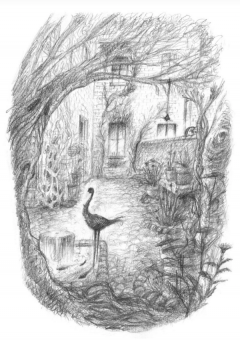 RB: Thank you! I’m not a meticulous thumbnail-er. Although I may be on my next book! Yes, I’m probably a more fluid planner. I did a lot of plotting and re-plotting for probably about 6 months before writing the story. After having a rough idea of what MAY happen in each chapter , I scripted a chapter, edited and did a very rough storyboard of it. Then drew each chapter. I don’t write or thumbnail the whole thing. The plus side of this process is a. It doesn’t get boring and b. Since GNs take so long to do, you benefit from maturation and new ideas are coming to you all the time about how you can change things. It keeps it fresh!
RB: Thank you! I’m not a meticulous thumbnail-er. Although I may be on my next book! Yes, I’m probably a more fluid planner. I did a lot of plotting and re-plotting for probably about 6 months before writing the story. After having a rough idea of what MAY happen in each chapter , I scripted a chapter, edited and did a very rough storyboard of it. Then drew each chapter. I don’t write or thumbnail the whole thing. The plus side of this process is a. It doesn’t get boring and b. Since GNs take so long to do, you benefit from maturation and new ideas are coming to you all the time about how you can change things. It keeps it fresh!
The down side is you can go way over the page count which must be annoying for the publisher. Oh and you end up with really heavy books!!
The pencilling felt right for my last two books. They had a starkness (which was appropriate for The Inflatable Woman), and created a sense of nostalgia which was perfect for Wolf. I just love the simplicity and subtlety you can create with a pencil. Also I work really hard at getting facial and body expressions right and a pencil and rubber is right for that.
Can I just say the Palomino Blackwing pencil is the Queen of pencils!!
Who are your influences as a comic creator and what inspired you to get into making comics in the first place?
RB: I grew up with lots of cartoon books by Giles and Jules Feiffer. I think they were very influential. I have a memory of copying the Gile’s grandma when I was about 4 or 5. I realised recently after finishing the book that Iris in The Inflatable Woman looks just like Jules Ffeiffer’s Passionella character! Giles and Ffeiffer were both fantastic at observing humans and human behaviour. Also Daumier…lovely combination of humans, social satire and the elegance and atmosphere of his work is second to none. Mervyn Peake’s illustrations in Gormenghast; Thackeray’s illustrations in The Rose and The Ring and Robin Jacque’s illustrated fairy tales.
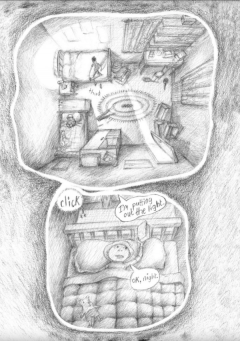 When I started cartooning pre-Deadline it was Claire Bretecher and then Lorenzo Mattotti, Art Spiegelman and Jim Wood-ring.
When I started cartooning pre-Deadline it was Claire Bretecher and then Lorenzo Mattotti, Art Spiegelman and Jim Wood-ring.
More recently: Lynda Barry, Jillian Tamaki, Roz Chast, Lucille ( Ludovdc Debeurme), and swoon ‘Beautiful Darkness’ (Fabien Vehlmann and Kerascoet.)
It’s funny when you look back to the times when you’d didn’t know what your future career would be. Looking back it seems obvious what you would end up doing today. I was always reading comics. Big era of the girl’s comics- Tammy, Jinty etc… great stuff!
I was often drawing odd looking girls too when I was growing up. I remember finding it really annoying that girls had to be pretty in comics and illustrated books. probably what got me leaning towards caricature.. I read an article very recently about Moebius’ drawing process. He said ‘when drawing a female she must be perfect. One line in the wrong place and she’ll look odd’..Well good!!! Here’s to odd girls and more of them!! (The weird sexism of female depiction in comics!! Hard to get my head around!)
Anyway….At art college I studied Expressive Arts (Fine Art and Dance.) I mainly did abstract painting but the dance pieces I choreographed became very narrative. I absolutely loved Pina Bausch and she became very influential on me when I was writing both graphic novels. I also used to make small illustrated dream books which I never took seriously at the time.
When I left college I didn’t have a clue what to do and after a stint of travelling I saw an ad for a cartoonist from Manchester’s listing mag City Life. I entered and won and ended up doing strips for them for a few years. I sent a bundle of the strips to Deadline and then worked for them for 3 years or maybe 4 years
I think I’ve waffled on too much there!!
 And finally what are you working on next?
And finally what are you working on next?
RB: My next project is called ‘ The Patsy Papers‘ Its a satirical take on my experiences working in state schools for 16 years and focuses on the effect of austerity on state schools and the quality of education and behaviour.
In particular it focuses on a new Head who took over my school in the last 2 years of my teaching experience and effectively ruined the school because of a combination of ruthless cuts to the number of staff and by dismantling the pastoral and behavioural system.
In my story the new Head has sinister motives and implements a Medieval ethos and House system to the school which should be lots if fun. The main character is Patsy who has just ended her teachers training and goes into the school like a lamb to the slaughter or perhaps like a hero about to be unleashed?! Theres lots of references to Macbeth’s witches, Mrs Danvers in Rebecca and all manner of other things too.
It’s going to be in colour this one too!
I’m working on a children’s book on the side as well and working with Laydeez do comics on lots of different projects this year. And running 4 workshops this year at the House of Illustration on different aspects of writing and illustrating graphic novels.
You can purchase Wolf from selfmadehero.com/books/wolf and find out more about Rachael’s work at rachaelball.tumblr.com/ or follow her on twitter @rachaelcartoons



October 8, 2025 @ 2:45 pm
One of the best reads I’ve had this week. Stream equidia pronostic — live horse racing and Quinté+ focus. programmes and tips throughout the day. post‑race highlights, racecards and odds, paddock views. programmes and tips throughout the day.
December 20, 2025 @ 2:35 am
Zudem ist es jedem Spieler jederzeit möglich
sich für eine bestimmte Dauer oder sogar dauerhaft im Platincasino zu
sperren. Und auch hier zeichnet sich das Platincasino aus, da es unter anderem dafür sorgt, dass sich Spieler selbst Limits setzen können und diese auch eingehalten werden. Somit kannst Du sichergehen, dass die Abläufe im Casino den höchsten Standards entsprechen. Wie jedes gute Online
Casino hält das Platincasino alle Auflagen ein, welche
für eine EU-Lizenz benötigt werden. Vor allem bei Zahlungsdaten ist dies besonders wichtig und gehört zu den Standards der Branche.
Und hier überzeugt das Platincasino zudem auf ganzer Linie.
Ein sicherer Platincasino Login-Prozess ist Ihre erste Verteidigungslinie gegen unbefugten Zugriff.
Es ist einer der effektivsten Schritte, die
Sie unternehmen können, um Ihr Guthaben zu schützen und
mit vollständiger Sicherheit zu spielen. Es stellt sicher, dass Ihr Spielerlebnis bei Platincasino Spaß macht, fair und ausschließlich Ihnen gehört.
Befolgen Sie diese einfachen Schritte, um wieder Zugriff zu
erhalten und Ihr Konto mit einem neuen Passwort zu sichern. Lassen Sie uns
einen kurzen Leitfaden zur Fehlerbehebung durchgehen, um Sie schnell wieder
in Ihr Platincasino-Konto zu bringen.
Erstens bietet das Casino ein attraktives Willkommenspaket für neue Spieler, das bis zu
2.000 € und 200 Freispiele umfasst. Hier finden Spieler über 4.400 verschiedene Spiele, darunter
Spielautomaten, Tischspiele und Live-Dealer-Angebote.
Mit einer benutzerfreundlichen Plattform und einer breiten Auswahl an Spielen ist es eine beliebte Wahl für Glücksspielenthusiasten. Mit über 4.400 verfügbaren Spielen, darunter
Spielautomaten, Tischspiele und Live-Dealer-Spiele,
ist es eine attraktive Wahl für Glücksspielenthusiasten. “Gewinnauszahlungen sind schnell, was ein großes Plus ist. Ich hatte nie Probleme mit Finanzen.” “Die mobile App funktioniert einwandfrei, ich kann überall und jederzeit spielen.”
References:
https://online-spielhallen.de/buran-casino-cashback-ihr-weg-zu-verlorenen-einsatzen-zuruck/
December 20, 2025 @ 7:07 am
Bremen ist nicht nur Hansestadt, sondern auch gleichzeitig
ein Bundesland bestehend aus den Städten Bremen und Bremerhaven. Für
Poker stehen zwölf Tische bereit, außerdem finden regelmäßig Pokerturniere statt.
Poker Turniere finden regelmäßig statt und für Abwechslung sorgen die 180 Spielautomaten.
Nahegelegene Parkhäuser bieten behindertengerechte Parkplätze, um einen bequemen Zugang
zu gewährleisten.
Per Handy und Tablet können Sie mit einer Casino App oder der mobilen Seite spielen. In jedem Testbericht informieren wir Sie
zur Spielauswahl mit Tisch- und Kartenspielen sowie Live Casino Games.
Das deutsche Glücksspielrecht gewährt dem Staat ein Monopol auf die Veranstaltung
von Glücksspielen, indem eine behördliche Erlaubnis einzuholen ist.
Die Hansestadt Bremen bietet Gelegenheiten zum Shoppen…
Eine große Vielfalt an Glücksspielen steht dort zur Verfügung.
Die Spielbank Bremen gehört derzeit noch zur Westspiel-Gruppe (Westdeutsche Spielbanken GmbH
& Co. KG), Kommanditisten der Bremer Spielcasino GmbH & Co.
Für Anfänger bietet das Casino Bremen von Montag bis Samstag unterschiedliche
Poker-Crashkurse an, in denen die Regeln spielerisch direkt am
Tisch erlernt werden. Friedrich Pohlmann ist selbst seit Jahren passionierter Automatenspieler und besucht in seiner Freizeit neben Automatencasinos
auch gerne Spielbanken. Dank der Anzahl von über 100 Spielotheken hast du überall in der Hansestadt die Möglichkeit, ein Spielcasino
in kürzester Zeit zu erreichen und Slots von Bally Wulff,
Novoline oder Merkur mit Einsätzen zwischen 5 Cent und
4 Euro zu spielen. Ziel der ECA ist es, ein faires und kontrolliertes
Glücksspiel anzubieten und für den Konsumenten so ein sicheres
Umfeld und ein verantwortungsbewusstes Spielangebot zu gewährleisten.
Allerdings bietet die Bar neben Getränken auch kleine Snacks an, damit
Sie nicht hungrig spielen müssen. Deshalb teilen wir
Ihnen heute mit, warum Sie dort spielen sollten, zu welchen Zeiten sie geöffnet haben,
wie gut die Spiele sind und welche Zusatzangebote Sie
dort erwarten.
References:
https://online-spielhallen.de/iwild-casino-cashback-ihr-weg-zum-verlorenen-geld-zuruck/